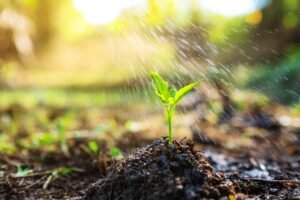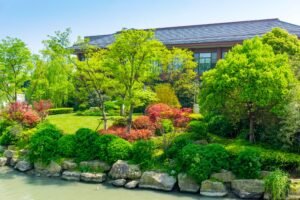As a Maryland homeowner, creating a vibrant and inviting outdoor space can greatly enhance your property’s curb appeal and overall enjoyment. Whether you’re looking to cultivate lush gardens, design a serene patio area, or simply maintain a thriving lawn, understanding the unique climate and soil conditions of Maryland is essential. From selecting the right native plants that flourish in the Mid-Atlantic region to implementing effective watering strategies, these essential landscaping tips will help you transform your yard into a picturesque oasis. With the changing seasons, practical landscaping techniques can ensure your outdoor space thrives year-round, providing a beautiful environment for relaxation and entertaining. Dive into our guide and discover how you can elevate your landscaping game while adding value to your home. Let’s dig in and explore the essential tips that will turn your Maryland yard into a stunning landscape!
Table of Contents
- Understanding Maryland's Climate and Soil
- Choosing the Right Plants for Your Landscape
- Designing a Functional Landscape Layout
- Seasonal Landscaping Tasks for Maryland Homeowners
- Sustainable Landscaping Practices
- Incorporating Hardscaping Elements
- Maintaining Your Landscape: Tips and Tricks
- Common Pests and Diseases in Maryland Gardens
- Hiring a Professional Landscaper vs. DIY
- Conclusion: Transforming Your Maryland Home with Landscaping
Understanding Maryland's Climate and Soil
Choosing the Right Plants for Your Landscape
Designing a Functional Landscape Layout
A well-designed landscape layout not only enhances the beauty of your property but also improves its functionality and usability. Start by considering how you and your family use your outdoor space. Do you need areas for entertaining, playing, gardening, or simply relaxing? Once you have identified your needs, you can begin to plan the layout of your landscape accordingly. Creating separate zones for different activities can help to organize your space and make it more enjoyable to use.
Incorporating pathways and patios into your landscape design can improve access and flow between different areas of your yard. Pathways can be made from a variety of materials, such as gravel, stone, or pavers, and should be wide enough to accommodate foot traffic comfortably. Patios provide a durable and attractive surface for outdoor furniture and can be designed to blend seamlessly with the surrounding landscape. Consider adding features like pergolas, arbors, or trellises to provide shade and vertical interest.
When designing your landscape, think about the balance and proportion of different elements. A mix of plant heights, textures, and colors can create a visually appealing and dynamic garden. Use larger shrubs and trees to anchor the space and provide structure, while smaller plants and groundcovers can fill in gaps and add detail. Don’t forget to incorporate focal points, such as a water feature, sculpture, or specimen plant, to draw the eye and create a sense of harmony. By carefully planning your landscape layout, you can create an outdoor space that is both beautiful and functional.
Seasonal Landscaping Tasks for Maryland Homeowners
Maintaining a beautiful landscape in Maryland requires attention to seasonal tasks that keep your garden looking its best throughout the year. In the spring, focus on preparing your garden for the growing season by cleaning up debris, pruning dead or damaged branches, and refreshing mulch. This is also an excellent time to plant new flowers, shrubs, and trees, as the moderate temperatures and ample rainfall help new plants establish quickly. Consider applying a balanced fertilizer to give your plants a boost and promote healthy growth.
Summer in Maryland can be hot and humid, making it essential to keep your garden well-watered. Water early in the morning or late in the evening to minimize evaporation and ensure that your plants receive the moisture they need. Regularly deadhead spent flowers to encourage continuous blooming and prevent disease. Keep an eye out for pests and diseases, and address any issues promptly to prevent them from spreading. Mulching around your plants can help to conserve moisture, suppress weeds, and regulate soil temperature.
Fall is the time to prepare your garden for the winter months ahead. Clean up fallen leaves and plant debris to prevent the spread of disease and pests. Cut back perennials and ornamental grasses to tidy up the garden and reduce winter damage. Fall is also an ideal time to plant bulbs for spring blooms, as well as to divide and transplant perennials. Consider adding a layer of mulch to protect plant roots from freezing temperatures. By staying on top of these seasonal tasks, you can ensure that your Maryland landscape remains healthy and vibrant year-round.
Sustainable Landscaping Practices
Sustainable landscaping practices not only benefit the environment but can also save you time and money in the long run. One of the most important aspects of sustainable landscaping is water conservation. Implementing efficient watering techniques, such as drip irrigation or soaker hoses, can significantly reduce water usage compared to traditional sprinklers. Collecting rainwater in barrels and using it to water your garden is another effective way to conserve water.
Reducing chemical inputs, such as fertilizers and pesticides, is another key component of sustainable landscaping. Opt for organic or slow-release fertilizers that provide nutrients gradually and reduce the risk of runoff. Integrated pest management (IPM) techniques, which include monitoring for pests, using physical barriers, and encouraging beneficial insects, can help to keep pest populations in check without relying on harmful chemicals. Composting yard and kitchen waste not only reduces landfill waste but also creates nutrient-rich compost that can improve soil health and fertility.
Incorporating Hardscaping Elements
Hardscaping elements, such as patios, walkways, retaining walls, and water features, can add structure and functionality to your landscape while enhancing its aesthetic appeal. When planning hardscape features, consider how they will integrate with the existing landscape and complement the overall design. For example, using natural stone or brick can create a cohesive look that blends seamlessly with the surrounding garden.
Patios are a popular hardscaping feature that provides a durable and attractive surface for outdoor living spaces. Whether you choose concrete, pavers, or natural stone, a well-designed patio can serve as the perfect spot for dining, entertaining, or simply relaxing. Adding features like a fire pit, outdoor kitchen, or pergola can enhance the usability and enjoyment of your patio area.
Maintaining Your Landscape: Tips and Tricks
Regular maintenance is essential for keeping your landscape looking its best and ensuring the health and longevity of your plants. One of the most important aspects of landscape maintenance is proper watering. Established plants typically need about an inch of water per week, either from rainfall or supplemental irrigation. Be sure to water deeply and infrequently to encourage deep root growth and reduce the risk of disease.
Mulching is another critical maintenance task that provides numerous benefits for your garden. A layer of mulch helps to conserve moisture, suppress weeds, regulate soil temperature, and improve soil structure as it breaks down. Organic mulches, such as shredded bark, wood chips, or compost, are excellent choices that also add nutrients to the soil over time. Be sure to apply mulch evenly and avoid piling it against the stems or trunks of plants, which can cause rot.
Pruning is essential for maintaining the shape and health of your plants. Regularly remove dead, damaged, or diseased branches to prevent the spread of disease and encourage new growth. Pruning can also help to
improve air circulation and light penetration, which can reduce the risk of fungal infections. Different plants have different pruning requirements, so be sure to research the specific needs of each plant in your garden.
Weed control is another important aspect of landscape maintenance. Weeds compete with your plants for water, nutrients, and light, so it’s essential to keep them in check. Hand-pulling, hoeing, and applying mulch are effective methods for controlling weeds without using chemicals. For larger areas, consider using landscape fabric or organic herbicides. By staying on top of these maintenance tasks, you can ensure that your Maryland landscape remains healthy and beautiful throughout the year.
Common Pests and Diseases in Maryland Gardens
Maryland gardens can be susceptible to a variety of pests and diseases that can impact the health and appearance of your plants. Common pests in the region include aphids, Japanese beetles, and spider mites. Aphids are small, soft-bodied insects that feed on plant sap, causing distorted growth and yellowing leaves. Japanese beetles are voracious feeders that can skeletonize leaves, while spider mites can cause stippling and webbing on foliage. Regular monitoring and early intervention are key to managing these pests.
Integrated pest management (IPM) is an effective approach to controlling pests in your garden. IPM involves a combination of cultural, physical, and biological controls to keep pest populations in check. Cultural controls include practices such as proper watering, mulching, and crop rotation to create an environment that is less conducive to pests. Physical controls involve removing pests by hand, using barriers or traps, and applying organic insecticides when necessary. Biological controls involve encouraging natural predators, such as ladybugs and beneficial nematodes, to help manage pest populations.
Diseases can also pose a threat to your garden. Common diseases in Maryland gardens include powdery mildew, black spot, and blight. Powdery mildew is a fungal disease that causes a white, powdery coating on leaves and stems. Black spot is another fungal disease that causes dark, circular spots on leaves, leading to defoliation. Blight is a bacterial or fungal disease that can cause wilting, browning, and plant death. Preventing disease involves proper cultural practices, such as providing adequate spacing for air circulation, watering at the base of plants, and removing infected plant material. Fungicides and bactericides can also be used as a last resort to manage severe infections.
By staying vigilant and implementing IPM strategies, you can protect your garden from common pests and diseases and ensure that your plants remain healthy and vibrant.
Hiring a Professional Landscaper vs. DIY
When it comes to landscaping your Maryland home, you may be faced with the decision of whether to hire a professional landscaper or tackle the project yourself. Both options have their advantages and considerations, and the best choice depends on your budget, time, and level of expertise.
Hiring a professional landscaper can offer several benefits. Professionals have the knowledge and experience to design and implement a landscape that meets your specific needs and preferences. They can provide expert advice on plant selection, soil amendments, and irrigation systems, ensuring that your garden thrives. Additionally, professional landscapers have access to specialized equipment and resources that can make the installation and maintenance process more efficient. If you have a large or complex project, hiring a professional can save you time and effort and ensure a high-quality result.
On the other hand, taking a DIY approach to landscaping can be a rewarding and cost-effective option. DIY landscaping allows you to have complete control over the design and implementation of your garden, and it can be a fulfilling creative outlet. There are numerous resources available, including books, online tutorials, and gardening classes, that can help you develop the skills and knowledge needed to create a beautiful landscape. DIY landscaping can also be done at your own pace, allowing you to spread out the work and costs over time.
Ultimately, the decision to hire a professional landscaper or go the DIY route depends on your individual circumstances. If you have the time, energy, and interest in gardening, a DIY project can be a satisfying and budget-friendly option. However, if you prefer to leave the work to the experts and ensure a polished and professional result, hiring a landscaper may be the best choice. Whichever option you choose, the most important thing is to create a landscape that brings you joy and enhances the beauty of your Maryland home.
Conclusion: Transforming Your Maryland Home with Landscaping
Landscaping is a powerful tool that can transform your Maryland home into a stunning and inviting oasis. By understanding the unique climate and soil conditions of the region, choosing the right plants, and designing a functional and beautiful landscape layout, you can create a garden that thrives year-round. Seasonal maintenance tasks and sustainable landscaping practices will help you keep your garden healthy and environmentally friendly. Incorporating hardscaping elements adds structure and functionality, while regular maintenance ensures that your landscape remains vibrant and well-kept.
Whether you decide to hire a professional landscaper or take on the project yourself, the key to successful landscaping is planning and attention to detail. By carefully considering your needs, preferences, and the specific conditions of your property, you can create a landscape that enhances your home’s curb appeal, provides a sanctuary for relaxation and enjoyment, and adds value to your property.
As you embark on your landscaping journey, remember that gardening is a process that evolves over time. Be patient and open to experimenting with different plants and designs to find what works best for your space. With dedication and creativity, you can turn your Maryland yard into a picturesque landscape that you and your family will enjoy for years to come. Happy gardening!
Categories
- Commercial (2)
- Hardscaping (2)
- Landscape Design (2)
- Residential (2)
Recent posts

Watering New Lawn Seed: The Ultimate Guide to

Simple Landscaping Tips for Maryland Homeowners

Enhancing Your Outdoor Space with Professional Hardscaping Services

Transform Your Outdoor Space with Professional Landscaping Services

The Ultimate Guide to Choosing the Right Commercial

